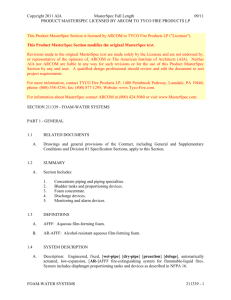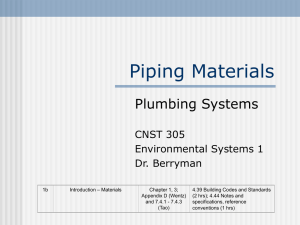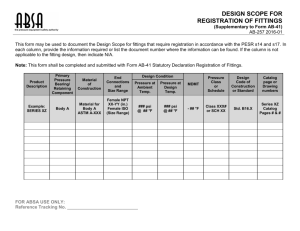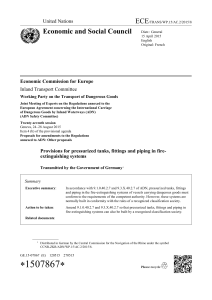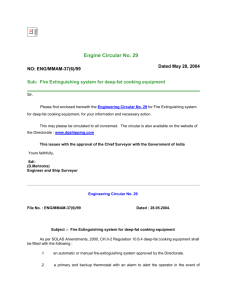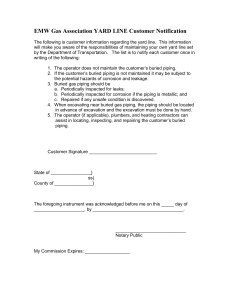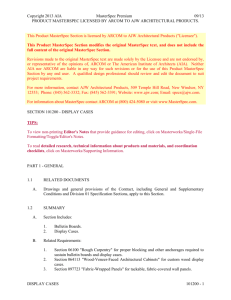212200 - clean-agent fire-extinguishing systems
advertisement
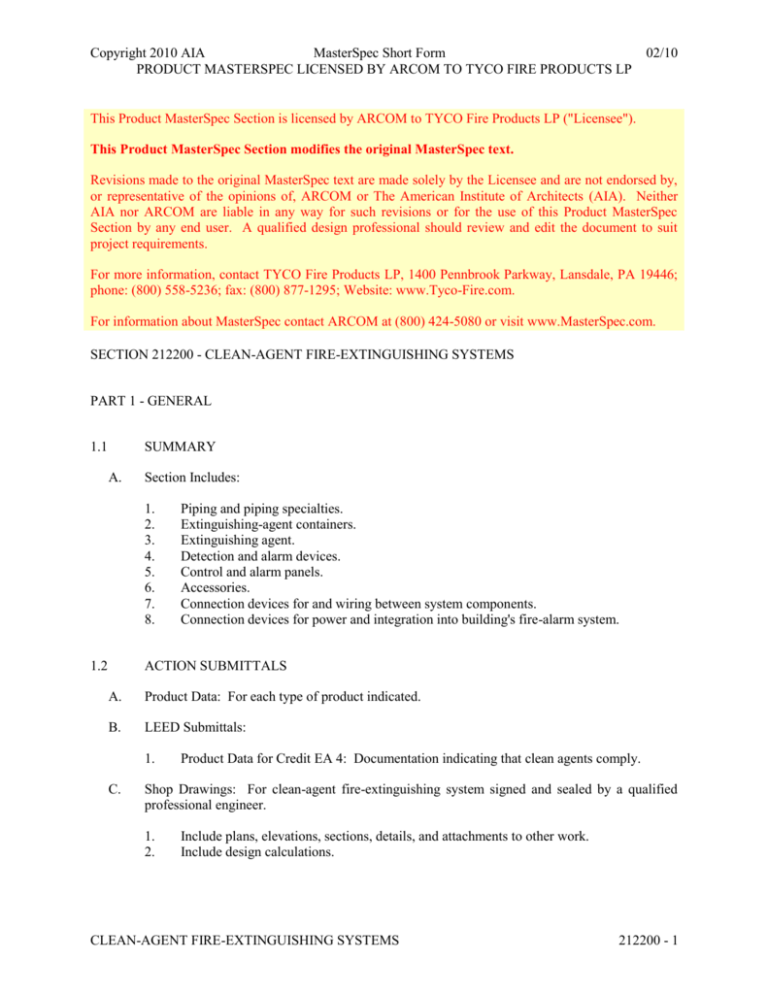
Copyright 2010 AIA MasterSpec Short Form PRODUCT MASTERSPEC LICENSED BY ARCOM TO TYCO FIRE PRODUCTS LP 02/10 This Product MasterSpec Section is licensed by ARCOM to TYCO Fire Products LP ("Licensee"). This Product MasterSpec Section modifies the original MasterSpec text. Revisions made to the original MasterSpec text are made solely by the Licensee and are not endorsed by, or representative of the opinions of, ARCOM or The American Institute of Architects (AIA). Neither AIA nor ARCOM are liable in any way for such revisions or for the use of this Product MasterSpec Section by any end user. A qualified design professional should review and edit the document to suit project requirements. For more information, contact TYCO Fire Products LP, 1400 Pennbrook Parkway, Lansdale, PA 19446; phone: (800) 558-5236; fax: (800) 877-1295; Website: www.Tyco-Fire.com. For information about MasterSpec contact ARCOM at (800) 424-5080 or visit www.MasterSpec.com. SECTION 212200 - CLEAN-AGENT FIRE-EXTINGUISHING SYSTEMS PART 1 - GENERAL 1.1 SUMMARY A. Section Includes: 1. 2. 3. 4. 5. 6. 7. 8. 1.2 Piping and piping specialties. Extinguishing-agent containers. Extinguishing agent. Detection and alarm devices. Control and alarm panels. Accessories. Connection devices for and wiring between system components. Connection devices for power and integration into building's fire-alarm system. ACTION SUBMITTALS A. Product Data: For each type of product indicated. B. LEED Submittals: 1. C. Product Data for Credit EA 4: Documentation indicating that clean agents comply. Shop Drawings: For clean-agent fire-extinguishing system signed and sealed by a qualified professional engineer. 1. 2. Include plans, elevations, sections, details, and attachments to other work. Include design calculations. CLEAN-AGENT FIRE-EXTINGUISHING SYSTEMS 212200 - 1 Copyright 2010 AIA MasterSpec Short Form PRODUCT MASTERSPEC LICENSED BY ARCOM TO TYCO FIRE PRODUCTS LP 3. 4. 1.3 02/10 Detail equipment assemblies and indicate dimensions, weights, loads, required clearances, method of field assembly, components, and location and size of each field connection. Wiring Diagrams: For power, signal, and control wiring. INFORMATIONAL SUBMITTALS A. Permit Approved Drawings: Working plans, prepared according to NFPA 2001, that have been approved by authorities having jurisdiction. Include design calculations. B. Field quality-control reports. C. Seismic Qualification Certificates: For extinguishing-agent containers and control panels from manufacturer. 1. 2. 3. 1.4 Basis for Certification: Indicate whether withstand certification is based on actual test of assembled components or on calculation. Dimensioned Outline Drawings of Equipment Unit: Identify center of gravity and locate and describe mounting and anchorage provisions. Detailed description of equipment anchorage devices on which the certification is based and their installation requirements. CLOSEOUT SUBMITTALS A. 1.5 Operation and maintenance data. QUALITY ASSURANCE A. Electrical Components, Devices, and Accessories: Listed and labeled as defined in NFPA 70, by a qualified testing agency, and marked for intended location and application. B. FM Global Compliance: Provide components that are FM Approved and that are listed in FM Global's "Approval Guide." C. UL Compliance: Provide equipment listed in UL's "Fire Protection Equipment Directory." PART 2 - PRODUCTS 2.1 CLEAN-AGENT SYSTEMS A. Basis-of-Design Product: Subject to compliance with requirements, provide [Ansul, a TYCO International Company; INERGEN] [Ansul, a TYCO International Company; SAPPHIRE] [PYRO_CHEM; FM 200] or comparable product by one of the following: 1. 2. 3. Chemetron Fire Systems; a UTC Fire & Security company. Fike Corporation. Pem All Fire Extinguisher Corporation; a division of Pem Systems Inc. CLEAN-AGENT FIRE-EXTINGUISHING SYSTEMS 212200 - 2 Copyright 2010 AIA MasterSpec Short Form PRODUCT MASTERSPEC LICENSED BY ARCOM TO TYCO FIRE PRODUCTS LP 4. 5. 02/10 Siemens Building Technologies, Inc.; Fire Safety Division. <Insert manufacturer's name>. B. Description: Clean-agent fire-extinguishing system shall be an engineered system for total flooding of the hazard area including the room cavity above the ceiling, below the ceiling, and below the raised floor. System includes separate zones above and below the ceiling and beneath the raised floor. If smoke is detected below the raised floor, extinguishing agent shall be discharged in the underfloor zone only. If smoke is detected below the ceiling, extinguishing agent shall be discharged in zones above and below the ceiling and below the floor. If smoke is detected above the ceiling, extinguishing agent shall be discharged in the zone above the ceiling only. C. Delegated Design: Design clean-agent fire-extinguishing system and obtain approval from authorities having jurisdiction. Design system for Class A, B, and C fires as appropriate for areas being protected, and include safety factor. Use clean agent indicated and in concentration suitable for normally occupied areas. D. Performance Requirements: 1. 2. 3. Performance requirements for HFC 227 per NFPA. Performance requirements for FK5 1 12 per NFPA 2001. Performance requirements for IG 541 per NFPA 2001. E. Cross-Zoned Detection: Devices located in two separate zones. Sound alarm on activating single-detection device, and discharge extinguishing agent on actuating single-detection device in other zone. F. System Operating Sequence: 1. 2. 3. Actuating First Detector: Visual indication on annunciator panel. Energize audible and visual alarms (slow pulse), shut down air-conditioning and ventilating systems serving protected area, close doors in protected area, and send signal to fire-alarm system. Actuating Second Detector: Visual indication on annunciator panel. Energize audible and visual alarms (fast pulse), shut down power to protected equipment, start time delay for extinguishing-agent discharge for [30] <Insert time> seconds, and discharge extinguishing agent.[ On agent discharge, release preaction valve to allow water to fill sprinkler system.] Extinguishing-agent discharge will operate audible alarms and strobe lights inside and outside the protected area. G. Manual stations shall immediately discharge extinguishing agent when activated. H. Operating abort switches will delay extinguishing-agent discharge while being activated, and switches must be reset to prevent agent discharge. Release of hand pressure on the switch will cause agent discharge if the time delay has expired. I. EPO: Will terminate power to protected equipment immediately on actuation. J. Low-Agent Pressure Switch: Initiate trouble alarm if sensing less than set pressure. K. Power Transfer Switch: Transfer from normal to stand-by power source. CLEAN-AGENT FIRE-EXTINGUISHING SYSTEMS 212200 - 3 Copyright 2010 AIA MasterSpec Short Form PRODUCT MASTERSPEC LICENSED BY ARCOM TO TYCO FIRE PRODUCTS LP L. Seismic Performance: Fire-suppression piping and containers shall withstand the effects of earthquake motions determined according to [ASCE/SEI 7] <Insert requirement>. 1. 2.2 02/10 The term "withstand" means "the unit will remain in place without separation of any parts from the device when subjected to the seismic forces specified[ and the unit will be fully operational after the seismic event]." PIPING MATERIALS A. See "Manufacturer's Installation Manual". Article for applications of pipe, tube, fitting, and joining materials. B. Piping, Valves, and Discharge Nozzles: Comply with types and standards listed in NFPA 2001, Section "Distribution," for charging pressure of system. 2.3 PIPE AND FITTINGS A. Steel Pipe: ASTM A 53/A 53M, Type S, Grade B or ASTM A 106/A 106M, Grade A ; Schedule 40, Schedule 80, and Schedule 160, seamless steel pipe. 1. Threaded Fittings: a. b. c. d. 2. 3. B. Malleable-Iron Fittings: ASME B16.3, Class 300. Flanges and Flanged Fittings: ASME B16.5, Class 300 unless Class 600 is indicated. Fittings Working Pressure: 620 psig (4278 kPa) minimum. Flanged Joints: Class 300 minimum. Forged-Steel Welding Fittings: ASME B16.11, Class 3000, socket pattern. Steel, Grooved-End Fittings: FM Approved and NRTL listed, ASTM A 47/A 47M malleable iron or ASTM A 536 ductile iron, with dimensions matching steel pipe and ends factory grooved according to AWWA C606. Pipe-Flange Gasket Materials: Suitable for chemical and thermal conditions of piping system contents. 1. ASME B16.21, nonmetallic, flat, asbestos-free, 1/8-inch (3.2-mm) maximum thickness unless thickness or specific material is indicated. C. Flange Bolts and Nuts: ASME B18.2.1, carbon steel. D. Welding Filler Metals: Comply with AWS D10.12M/D10.12 for welding materials appropriate for wall thickness and chemical analysis of steel pipe being welded. E. Steel, Keyed Couplings: UL 213, AWWA C606, approved or listed for clean-agent service, and matching steel-pipe dimensions. Include ASTM A 536, ductile-iron housing, rubber gasket, and steel bolts and nuts. CLEAN-AGENT FIRE-EXTINGUISHING SYSTEMS 212200 - 4 Copyright 2010 AIA MasterSpec Short Form PRODUCT MASTERSPEC LICENSED BY ARCOM TO TYCO FIRE PRODUCTS LP 2.4 02/10 VALVES A. General Valve Requirements: 1. 2. UL listed or FM Approved for use in fire-protection systems. Compatible with type of clean agent used. B. Container Valves: With rupture disc or solenoid and manual-release lever, capable of immediate and total agent discharge and suitable for intended flow capacity. C. Valves in Sections of Closed Piping and Manifolds: Fabricate to prevent entrapment of liquid, or install valve and separate pressure relief device. D. Valves in Manifolds: Check valve; installed to prevent loss of extinguishing agent when container is removed from manifold. 2.5 EXTINGUISHING-AGENT CONTAINERS A. Description: Steel tanks complying with ASME Boiler and Pressure Vessel Code: Section VIII, for unfired pressure vessels. Include minimum working-pressure rating that matches system charging pressure, valve, pressure switch, and pressure gage. 1. 2. 3. 4. 2.6 Finish: [Red] [Manufacturer's standard color], enamel or epoxy paint. Manifold: Fabricate with valves, pressure switches, and connections for multiple storage containers, as indicated. Manifold: Fabricate with valves, pressure switches, selector switch, and connections for main- and reserve-supply banks of multiple storage containers. Storage-Tank Brackets: Factory- or field-fabricated retaining brackets consisting of steel straps and channels; suitable for container support, maintenance, and tank refilling or replacement. FIRE-EXTINGUISHING CLEAN AGENT A. HFC 227ea Clean Agent: Heptafluoropropane. 1. Basis-of-Design Product: Subject to compliance with requirements, provide PYRO_CHEM; FM 200 or comparable product by one of the following: a. b. c. B. DuPont. Great Lakes Chemical Corporation; a Chemtura company. <Insert manufacturer's name>. FK-5-1-12 Clean Agent: Dodecaflouro-2-methylpentan-3-one. 1. Basis-of-Design Product: Subject to compliance with requirements, provide Ansul, a TYCO International Company; SAPPHIRE or comparable product by one of the following: a. 3M. CLEAN-AGENT FIRE-EXTINGUISHING SYSTEMS 212200 - 5 Copyright 2010 AIA MasterSpec Short Form PRODUCT MASTERSPEC LICENSED BY ARCOM TO TYCO FIRE PRODUCTS LP b. C. <Insert manufacturer's name>. IG-541 Clean Agent: Mixture of nitrogen, argon, and carbon dioxide inert gases. 1. Basis-of-Design Product: Subject to compliance with requirements, provide Ansul, a TYCO International Company; INERGEN or comparable product by one of the following: a. 2.7 02/10 <Insert manufacturer's name>. DISCHARGE NOZZLES A. 2.8 Equipment manufacturer's standard one-piece brass or aluminum alloy of type, size, discharge pattern, and capacity required for application. CONTROL PANELS A. Description: FM Approved or NRTL listed, including equipment and features required for testing, supervising, and operating fire-extinguishing system. B. Power Requirements: 120/240-V ac; with electrical contacts for connection to system components and fire-alarm system, and transformer or rectifier as needed to produce power at voltage required for accessories and alarm devices. C. Enclosure: NEMA ICS 6, Type 1, enameled-steel cabinet. 1. D. Supervised Circuits: Separate circuits for each independent hazard area. 1. 2. 3. 4. 5. 6. E. Detection circuits equal to the required number of zones, or addressable devices assigned to the required number of zones. Manual pull-station circuit. Alarm circuit. Release circuit. Abort circuit. EPO circuit. Control-Panel Features: 1. 2. 3. 4. F. Mounting: [Recessed flush with surface] [Surface]. Electrical contacts for shutting down fans, activating dampers, and operating system electrical devices. Automatic switchover to standby power at loss of primary power. Storage container, low-pressure indicator. Service disconnect to interrupt system operation for maintenance with visual status indication on the annunciator panel. Annunciator Panel: Graphic type showing protected, hazard-area plans, as well as locations of detectors and abort, EPO, and manual stations. Include lamps to indicate device-initiating CLEAN-AGENT FIRE-EXTINGUISHING SYSTEMS 212200 - 6 Copyright 2010 AIA MasterSpec Short Form PRODUCT MASTERSPEC LICENSED BY ARCOM TO TYCO FIRE PRODUCTS LP 02/10 alarm, electrical contacts for connection to control panel, and stainless-steel or aluminum enclosure. G. 2.9 Standby Power: [Sealed lead calcium] [Sealed, valve-regulated, recombinant lead acid] [Vented, wet-cell pocket, plate nickel cadmium] batteries with capacity to operate system for 24 hours and alarm for minimum of 15 minutes. Include automatic battery charger that has a varying charging rate between trickle and high depending on battery voltage, and that is capable of maintaining batteries fully charged. Include manual voltage control, dc voltmeter, dc ammeter, electrical contacts for connection to control panel, automatic transfer switch, and suitable enclosure. DETECTION DEVICES A. General Requirements for Detection Devices: 1. 2. Comply with NFPA 2001, NFPA 72, and UL 268. 24-V dc, nominal. B. Ionization Detectors: Dual-chamber type, having sampling and referencing chambers, with smoke-sensing element. C. Photoelectric Detectors: LED light source and silicon photodiode receiving element. D. Signals to the Central Fire Alarm Control Panel: Any type of local system trouble is reported to the central fire alarm control panel as a composite "trouble" signal. Alarms on each system zone are individually reported to the central fire alarm control panel as separately identified zones. 2.10 MANUAL STATIONS A. General Description: [Surface] [Semirecessed] FM Approved or NRTL listed, with clear plastic hinged cover, 120-V ac or low voltage compatible with controls. Include contacts for connection to control panel. B. Manual Release: "MANUAL RELEASE" caption, and red finish. Unit can manually discharge extinguishing agent with operating device that remains engaged until unlocked. C. Abort Switch: "ABORT" caption, momentary contact, with green finish. D. EPO Switch: "EPO" caption, with yellow finish. 2.11 A. SWITCHES Description: FM Approved or NRTL listed, where available, [120-V] <Insert value> ac or low voltage compatible with controls. Include contacts for connection to control panel. 1. Low-Agent Pressure Switches: Pneumatic operation. CLEAN-AGENT FIRE-EXTINGUISHING SYSTEMS 212200 - 7 Copyright 2010 AIA MasterSpec Short Form PRODUCT MASTERSPEC LICENSED BY ARCOM TO TYCO FIRE PRODUCTS LP 2. 3. 2.12 02/10 Power Transfer Switches: Key-operation selector, for transfer of release circuit signal from main supply to reserve supply. Door Closers: Magnetic retaining and release device or electrical interlock to cause the door operator to drive the door closed. ALARM DEVICES A. Description: Listed and labeled by an NRTL or FM Approved, low voltage, and surface mounting. Comply with requirements in Section 283111 "Digital, Addressable Fire-Alarm System" or Section 283112 "Zoned (DC Loop) Fire-Alarm System" for alarm and monitoring devices. B. Bells: Minimum 6-inch (150-mm) diameter. C. Horns: 90 to 94 dBA. D. Strobe Lights: Translucent lens, with "FIRE" or similar caption. PART 3 - EXECUTION 3.1 HFC 227ea agent PIPING APPLICATIONS A. Flanged pipe and fittings and flanged joints may be used to connect to specialties and accessories and where required for maintenance. B. NPS 2 (DN 50) and Smaller: Schedule 40, steel pipe; malleable-iron threaded fittings; and threaded joints. C. NPS 2-1/2 (DN 65) and Larger: Schedule 40, steel pipe; [forged-steel welding fittings; and welded joints] [steel, grooved-end fittings; steel, keyed couplings; and grooved joints]. 3.2 IG-541 AGENT PIPING APPLICATIONS A. Piping between Storage Containers and Orifice Union: Schedule [80] [160], steel pipe; [forgedsteel welding fittings; and welded joints] [malleable-iron fittings with threaded or flanged joints]. B. Piping Downstream from Orifice Union: Schedule [40] [80], steel pipe; [forged-steel welding fittings; and welded joints] [malleable-iron fittings with threaded or flanged joints]. 3.3 FK-5-1-12 AGENT PIPING APPLICATIONS A. Flanged pipe and fittings and flanged joints may be used to connect to specialties and accessories and where required for maintenance. B. NPS 2 (DN 50) and Smaller: Schedule 40, steel pipe; malleable-iron threaded fittings; and threaded joints. CLEAN-AGENT FIRE-EXTINGUISHING SYSTEMS 212200 - 8 Copyright 2010 AIA MasterSpec Short Form PRODUCT MASTERSPEC LICENSED BY ARCOM TO TYCO FIRE PRODUCTS LP C. 3.4 02/10 NPS 2-1/2 (DN 65) and Larger: Schedule 40, steel pipe; [forged-steel welding fittings; and welded joints] [steel, grooved-end fittings; steel, keyed couplings; and grooved joints]. CLEAN-AGENT PIPING INSTALLATION A. Install clean-agent extinguishing piping and other components level and plumb, according to manufacturers' written instructions. B. Grooved Piping Joints: Groove pipe ends according to AWWA C606 dimensions. Assemble grooved-end steel pipe and steel, grooved-end fittings with steel, keyed couplings and lubricant according to manufacturer's written instructions. C. Install extinguishing-agent containers anchored to substrate. D. Install pipe and fittings, valves, and discharge nozzles according to requirements listed in NFPA 2001, Section "Distribution." 1. 2. 3. 4. Install valves designed to prevent entrapment of liquid, or install pressure relief devices in valved sections of piping systems. Support piping using supports and methods according to NFPA 13. Install seismic restraints for extinguishing-agent containers and piping systems. Install control panels, detection system components, alarms, and accessories, complying with requirements of NFPA 2001, Section "Detection, Actuation, and Control Systems," as required for supervised system application. E. Drawings indicate general arrangement of piping, fittings, and specialties. F. Where installing piping adjacent to equipment, allow space for service and maintenance. G. Connect electrical devices to control panel and to building's fire-alarm system. Electrical power, wiring, and devices are specified in Section 283111 "Digital, Addressable Fire-Alarm System" or Section 283112 "Zoned (DC Loop) Fire-Alarm System." H. Identify piping, extinguishing-agent containers, other equipment, and panels according to NFPA 2001. I. Install signs at entry doors for protected areas to warn occupants that they are entering a room protected with a clean-agent fire-extinguishing system. J. Install signs at entry doors to advise persons outside the room the meaning of the horn(s), bell(s), and strobe light(s) outside the protected space. 3.5 FIELD QUALITY CONTROL A. Perform tests and inspections. 1. Manufacturer's Field Service: Engage a factory-authorized service representative to inspect components, assemblies, and equipment installations, including connections, and to assist in testing. CLEAN-AGENT FIRE-EXTINGUISHING SYSTEMS 212200 - 9 Copyright 2010 AIA MasterSpec Short Form PRODUCT MASTERSPEC LICENSED BY ARCOM TO TYCO FIRE PRODUCTS LP B. Tests and Inspections: 1. 2. 3. 4. 5. After installing clean-agent extinguishing piping system and after electrical circuitry has been energized, test for compliance with requirements. Perform each electrical test and visual and mechanical inspection stated in NETA ATS, Sections "Inspection and Test Procedures" and "System Function Tests." Certify compliance with test parameters. Leak Test: After installation, charge system and test for leaks. Repair leaks and retest until no leaks exist. Operational Test: After electrical circuitry has been energized, start units to confirm proper motor rotation and unit operation. Remove malfunctioning units, replace with new units, and retest. Test and adjust controls and safeties. Replace damaged and malfunctioning controls and equipment. C. Units will be considered defective if they do not pass tests and inspections. D. Prepare test and inspection reports. 3.6 02/10 SYSTEM FILLING A. Preparation: 1. 2. 3. B. Filling Procedures: 1. 2. 3. 4. 3.7 Verify that piping system installation is completed and cleaned. Check for complete enclosure integrity. Check operation of ventilation and exhaust systems. Fill extinguishing-agent containers with extinguishing agent, and pressurize to indicated charging pressure. Install filled extinguishing-agent containers. Energize circuits. Adjust operating controls. DEMONSTRATION A. [Engage a factory-authorized service representative to train] [Train] Owner's maintenance personnel to adjust, operate, and maintain clean-agent fire-extinguishing systems. END OF SECTION 212200 CLEAN-AGENT FIRE-EXTINGUISHING SYSTEMS 212200 - 10


